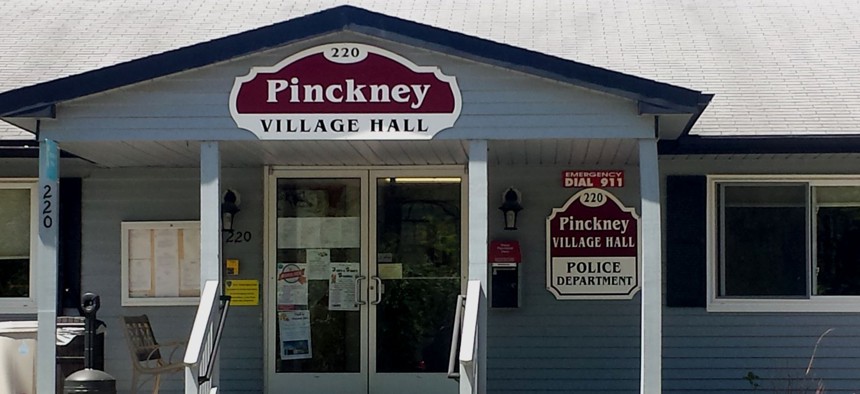Route Fifty Roadmap: The Road to Hell Goes Through This Michigan Village

Want to go to Hell? Start here. Michael Grass / RouteFifty.com

Connecting state and local government leaders
A recent discovery in woods near Hell: One of the oldest known freshwater turtles.
Route Fifty Roadmap is an ongoing series of dispatches from the semi-regular travels of the Route Fifty staff around the United States. | PREVIOUSLY: Bucksport, Maine
PINCKNEY, Mich. — Traveling between Lansing and Ann Arbor, most people stick to the freeways, Interstate 96 and U.S. 23. But if you’re not in a hurry, I’ve found that M-36 is a nice alternative, winding its way through some scenic agricultural and forest land.
It’s sometimes hard to pinpoint exactly where Detroit’s far western exurbs end. But Livingston County, which has around 180,000 residents, certainly includes small communities like Pinckney, which are not only on the fringe of the greater Metro Detroit region—downtown Detroit is about an hour away driving, assuming traffic conditions are good—but is also within the orbits of Lansing and Ann Arbor, which are within commuting distance.
Pinckney, first settled in 1827 and platted in 1837—the same year Michigan became a state, is a village with around 2,500 residents. These days, Pinckney isn’t known for much that would necessarily put it on the map of greater awareness. But in the 19th century, the place inspired author Caroline Kirkland, who crafted a narrative of frontier life in a newly founded village in the 1839 book A New Home—Who’ll Follow?
Also, if you’re intent on going to Hell, you have to drive through Pinckney.
There’s a big sign in the center of the village, just down the way from the village hall, that points to Hell.

That curiously named unincorporated community is about three and a half miles down the road.
Hell, as you can probably expect, is a bit of a local tourist draw. You can get married in Hell. There’s also the Hell-Hole Diner and Bar—according to a recent Yelp review, it’s a “Helluva a place!”
And there’s hiking, canoeing and kayaking in the 11,000 acre Pinckney Recreation Area.
Hell is surrounded by the Edwin S. George Reserve, which is overseen by the University of Michigan’s Department of Ecology and Evolutionary Biology. The reserve, home to a wide variety of flora and fauna, has been used for many long- and short-term biological research projects over the years, including tracking turtles.

In May, the university announced that researchers at the reserve found a female Blanding’s turtle that they believe is at least 83 years old. The turtle in question, known as 3R11L, was first captured and marked in 1954, a year after the reserve started its long-term turtle study.
According to the university, 3R11L, has been recaptured more than 50 times since. And it’s believed that 3R11L is the oldest known freshwater turtle. The previous record was a 76-year-old Blanding’s turtle in Minnesota.
"This is just one example that shows the importance of our multigenerational investment in the biological sciences," Andrew Martin, the dean of the U-M College of Literature, Sciences and the Arts, said in a statement.
You probably didn't expect that in Hell.
Michael Grass is Executive Editor of Government Executive's Route Fifty. He is based in Seattle.

NEXT STORY: Mapping the Problem of Elder Abuse





